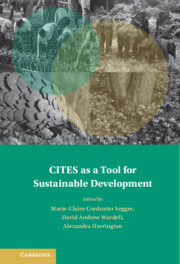Book contents
- CITES as a Tool for Sustainable Development
- Treaty Implementation for Sustainable Development
- CITES as a Tool for Sustainable Development
- Copyright page
- Contents
- Figures
- Tables
- Boxes
- Notes on Contributors
- Preface by CITES Secretary-General, Ivonne Higuero
- Foreword by Honorable Judge Antonio H. Benjamin
- Acknowledgments
- Abbreviations
- Part I Endangered Species, Sustainable Development and the Law
- Part II Sustainable Development in Law and Policy on Endangered Species
- Part III Global Implementation of CITES by Key Species/Commodity
- 7 Power, Profits and Policy: A Reality Check on CITES and the Prunus africana Bark Trade
- 8 The Inclusion of the Scalloped Hammerhead Shark (Sphyrna lewini) in Appendix II of CITES
- 9 Understanding Markets to Conserve CITES-Listed Species
- 10 Predator to Wisdom: INTERPOL NESTs and Sustainable Development
- Part IV National Implementation of CITES
- Part V Emerging Issues and Synergies for CITES in the Context of Sustainable Development
- Part VI Conclusions
- Cases and Court Decisions
- CITES Resolutions and Documents
- Domestic Acts and Regulations
- Multilateral Treaties and Declarations
- Recommended Resources
9 - Understanding Markets to Conserve CITES-Listed Species
from Part III - Global Implementation of CITES by Key Species/Commodity
Published online by Cambridge University Press: 27 July 2023
- CITES as a Tool for Sustainable Development
- Treaty Implementation for Sustainable Development
- CITES as a Tool for Sustainable Development
- Copyright page
- Contents
- Figures
- Tables
- Boxes
- Notes on Contributors
- Preface by CITES Secretary-General, Ivonne Higuero
- Foreword by Honorable Judge Antonio H. Benjamin
- Acknowledgments
- Abbreviations
- Part I Endangered Species, Sustainable Development and the Law
- Part II Sustainable Development in Law and Policy on Endangered Species
- Part III Global Implementation of CITES by Key Species/Commodity
- 7 Power, Profits and Policy: A Reality Check on CITES and the Prunus africana Bark Trade
- 8 The Inclusion of the Scalloped Hammerhead Shark (Sphyrna lewini) in Appendix II of CITES
- 9 Understanding Markets to Conserve CITES-Listed Species
- 10 Predator to Wisdom: INTERPOL NESTs and Sustainable Development
- Part IV National Implementation of CITES
- Part V Emerging Issues and Synergies for CITES in the Context of Sustainable Development
- Part VI Conclusions
- Cases and Court Decisions
- CITES Resolutions and Documents
- Domestic Acts and Regulations
- Multilateral Treaties and Declarations
- Recommended Resources
Summary
The authors note that historical responses to the conservation and sustainable use of wildlife have been predominantly regulatory, relying largely on the implementation of CITES. However, these supply-centric approaches have at best had mixed effectiveness, while CITES largely disregards the economic reality of wildlife trade in implementation terms. In this chapter, the authors examine the outcome of CITES policies on the trade and conservation of pangolins (Manis spp.) in Asia, specifically an Appendix II listing, inclusion in multiple phases of the Review of Significant Trade process, and a proposed transfer to Appendix I at CoP11 in 2000. They argue that reforms to this supply-centric approach are needed urgently, and which should include an explicit and in-depth understanding of consumer demand factors, and changing market dynamics (e.g., rapidly increasing demand, rising prices).
- Type
- Chapter
- Information
- CITES as a Tool for Sustainable Development , pp. 151 - 163Publisher: Cambridge University PressPrint publication year: 2023



